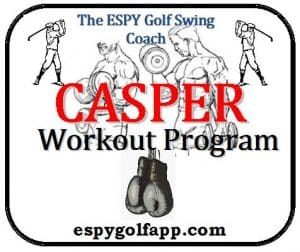The QATSPY Golf Sports Page: Simple Golf Swing Tips


By: Charles W. Boatright
Author of The ESPY Golf Swing Coach, Delta Technique Geared for Distance and Control
Golf Swing Coaching Technique: Takes the Golf Swing Compared to Baseball Swing Indicated in a Time-lapse Photography
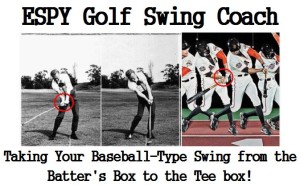
The main objective in The ESPY Golf Swing Coach technique is to convince the golfer’s mind that they can actually use a well-developed skill from their baseball swing sequence in the batter’s box and carry these skills to the tee box and onto the golf course. This golf swing coaching technique I’m referring to is called the Apperception process. The Apperception process is where skills used in one sport, like baseball or tennis, can be used in golf to help improve the coaching and learning process for the golfer.
The best memories that I have while growing up in the Ozarks of Arkansas in the summertime include playing baseball. We played almost every day in a makeshift hay field, where doormats served as our home plate and bases. If Mrs. Snodgrass missed her front doormat, she knew where the doormat went to and when it would be returned. The ground rules I still remember were that the fourth foul ball was an out, and a home run was over the gravel road at the back edge of the pasture. Our backstop was an old 1958 Chevy pickup truck with a piece of plywood leaning against the door of the cab. Most games would have been played without a back catcher.
Little did I realize it at the time, but I was working on the classic golf swing mechanics and the critical wrist action in the golf swing. Presetting the wrists and syncing the elbows with my shoulders were the direct results of playing baseball. This baseball-style golf swing coaching technique provided me the ability and confidence to access a well-developed muscle memory and motor skill that I had already developed playing baseball. The same baseball swing sequence of presetting my wrists that was naturally developed in the batter’s box helped me to confidently establish my golf swing sequence, based on three simple (Ergonomic Sync, Preset, and Yaw) elements, shown in the preset position below.
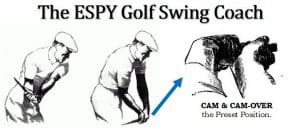
Sync and Preset to the Lock Position Figure
A major part of convincing the golfer’s mind is using a visualization process, which is a key self-coaching technique. Until you can visualize a specific technique, you are unable to fully apply that technique naturally. Visualization is a key component in the mental game of golf and also my book. Without visualization, the golfer can’t apply their natural skills of techniques and mechanics on a regular basis.
Golf Swing Time-Lapse Photo- Comparing the Golf Swing vs. Baseball Swing
Even if you have a strong hunch about a golf swing coaching technique and have practiced it, it’s not until you can actually see the evidence for yourself that you can have confidence in the concept and coaching techniques. Remember, visualization is key for the golfer, because the longest walk in golf is between the practice range and the first tee box, where all resemblance of a consistent golf swing seems to vanish. Your golf swing mechanics have to be ingrained as a muscle memory, in the golfer’s subconscious mind. The golfer’s subconscious mind acts like a refrigerator that only keeps muscle memory and motor skills fresh for a short period of time. Muscle memory has a short shelf life.
This is the reason that the golfer must constantly refresh these muscle memory and motor skills that are stored permanently in the permanent mind, or the unconscious mind. This is the reason during the winter months that the golfer can’t play golf or work on their golf swing mechanics, they lose their touch. Just by walking between the practice range to the first tee box, a lot can happen to this touch. One reason there is a conflict between the golfer’s conscious mind on the practice range and the subconscious mind on the golf course is the golfer’s adrenaline. I refer to this condition between the practice range and the first tee box as the Dr. Jekyll and Mr. Hyde golf syndrome. This syndrome can affect anyone at any time.
This elixir that Dr. Jekyll developed in his lab acts like adrenaline in the golfer’s mind. Adrenaline can do one of two things, FIRST situation, adrenaline can disrupt the natural interaction between the golfer’s conscious mind, where the golf swing techniques are and the golfer’s subconscious mind, where the golf swing mechanics are. This cuts off the biggest advantage the golfer has going for them. The golfer’s muscle memory and motor skills in the subconscious mind account for 90 percent of the golfer’s capabilities on the golf course. The SECOND preferred situation can happen, where adrenaline can hardwire the golfer’s conscious mind with their subconscious mind to help the golfer just to focus. Focusing creates a vivid image, like the time-lapse photo of the baseball swing from the Sync/Preset Lock; the Sync/Preset to the Lock Position is shown in the Figure above.
Between 2007 to 2014, I took a kinesiology course, when I started to address the Dr. Jekyll and Mr. Hyde syndrome in golf. I collected three Xerox boxes of research material during this period. As my research project for the Kinesiology course, I started looking closer at the typical baseball-style golf swing as a viable coaching technique for the golf swing. The more I studied the typical baseball-style golf swing for my kinesiology project, the more I was convinced that the golf swing sequence was based on the same muscle memory and motor skills that I developed for my baseball swing sequence as a kid. This confirmed the golf coaching technique in my book, The ESPY Golf Swing Coach, of syncing and presetting my wrist action in the golf swing sequence.
The Baseball-style Golf Swing: The Kinesiology Project
My grandfather used two terms to properly coach the Sync/Preset maneuver and to preset the correct wrist action in the golf swing, with the terms CAMMING and CAMMING-OVER. Syncing (CAMMING) the lower right forearm (for a right-handed golfer) and Presetting (CAMMING-OVER) the left wrist to lock the wrists and lower forearms into the Lock Position are shown in both the golf swing and baseball swing sequences.
There are three muscles that every golfer should become familiar with in the golf swing sequence. These are the Thenars (particularly, the Hypothenar), the Pronator Quadratus, and the Brachio-Radialis muscles. The Thenars are two of the strongest and most dexterous muscles that have direct contact with the handle of the golf club or baseball bat. For the right-handed golfer- the left Hypothenar, shown in the illustration below, presets the wrist in the time-lapse photo for the baseball and golf swings. The next critical muscle allows both the golfer and baseball player to sync the right lower forearm and right elbow with the shoulders. This Syncing/Presetting process allows the golfer to develop a tremendous mechanical advantage of synchronizing the elbows with the shoulders, like sprockets on a ten-speed bicycle.
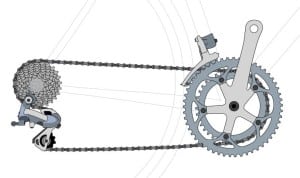
The third critical muscle, the Brachio-Radialis muscle, allows the golfer to flex, or bend, the right forearm at the right elbow. These three muscles are the right Pronator Quadratus muscle (Sync), the left Hypothenar muscle (Preset), and the right Brachio-Radialis muscle (Yaw) to help establish the entire golf swing sequence. To help facilitate these three muscle memories, I just trade in my golf glove in for a different type of glove, a pair of virtual boxing gloves, like how my grandfather coached golf. This creates all the muscle memory needed for power and speed in my golf swing sequence.
I use the virtual boxing gloves, in a right-handed golfer’s case, shown below, as if the boxing gloves are gripping a handle of a golf club. The boxing gloves are inverted in this illustration to help the golfer understand the correlation between the left wrist and the right lower forearm. The top left wristband (which is on bottom in this photo) represents my left Hypothenar (HY) muscle.
The bottom right wristband (which is on top in this photo) represents my Pronator Quadratus (BAR) muscle. Movement only takes place below this red synced line between the top left wristband and the bottom right wristband, where the three key muscles are located or interconnected. The axis of rotation (Ulna Bone) for each movement must remain stabilized, in other words, doesn’t rotate. Stabilization or fixed position is a key golf swing coaching technique. DO NOT underestimate the importance of stabilized axes, just like the spinal axis.

This is what all golfers need to learn to establish in the Sync/Preset wrist action in the golf swing sequence. This is a huge advantage that the golfer can use to improve their golf game and constancy. Learning to take the baseball-style golf swing from the batter’s box to the tee box is a huge advantage and a help for the golfer. This is also the slogan for my book.
The CAM and CAM-OVER Wrist Action in the Golf Swing
This comparison of the baseball-style golf swing was a significant part of my research project and book, where I placed so much emphasis on syncing and presetting the particular parts of the wristbands correctly. A great coaching technique to use to sync and preset the wrist action in the golf swing is the pair of boxing gloves to visualize the natural Sync (CAM), followed by the Preset (CAM-OVER) maneuver. This golf swing sequence allows the golfer to properly set the handle of the club onto the proper swing plane.
These two elements (CAM, followed immediately by CAMMING-OVER) properly syncs the elbows with the shoulders. This synchronizing of the golfer’s elbow (right elbow for the right-hander) with the shoulders naturally develops the power in the takeaway swing and the speed in the downswing, just how the bicyclist would shift gears to develop power and speed. The synchronization of the golfer’s right elbow with the shoulders is exactly how a ten-speed bicycle functions to provide a huge advantage of sprocket mechanics.

ESPY Golf Swing Sequence:
- Supinate (Sync) the right Pronator Quadratus Muscle (CAMS) about the right Ulna Bone to sync the right elbow with the shoulders.
- Pronate (Preset) the left Hypothenar Muscle (CAMS-OVER) about the left Ulna Bone to lock the right elbow with the shoulders.
- This places the right elbow into the LOCK Position and the handle of the golf club onto the correct swing plane for the YAW element, which is performed by the Brachio-Radialis Muscle.
The left Hypothenar and the right Pronator Quadratus Muscle are the KEY Muscles in the golfer’s swing and the ESPY Golf Swing sequence. These two muscles are located under the top and bottom parts of the wristband on the boxing glove, shown in the HY-BAR-RACK Muscle Memory Sequence Figure above.
A Vietnam War P.O.W. Personal Story of Using His Golf Swing to Survive the Hanoi Hilton
The ESPY golf swing sequence and technique is similar to the process Colonel George Robert Hall, whom I interviewed prior to my research project for this book in March of 2002. Col. Hall used the preset golf swing technique to maintain his muscle memory in his seven-and-a-half foot square prison cell. He referred to his prison cell as his Pebble Beach at the Hanoi Hilton for seven-and-a-half years as a POW to maintain his sanity and handicap of four.
The ESPY Golf Swing Coach also addresses issues with the modern-day golf swing, which are just now coming to light, especially with injuries; this is the ergonomics (E) part of my book. Peter Kostis wrote a great article in Sports Illustrated Golf Magazine, March 2016 issue, on page 38, that looks at these issues with the modern-day golf swing. The ESPY Golf Swing Coach is based on the classic golf swing mechanics, with some advancements with biomechanics added, like sprocket mechanics based on the baseball-type swing. This was the technique that I developed during my kinesiology project. This provides the golfer with a tremendous advantage to creating POWER and SPEED through impact.
Even in the boxing coaching process, the boxer is taught to keep their elbows close to their side and to deliver a punch between the pinky finger and the ring finger knuckle. Just above this spot of the pinky and ring knuckle is the Hypothenar that is also aligned with the Ulna Bone.

To learn how to take the baseball-style golf swing from the batter’s box to the tee box, purchase your copy of The ESPY Golf Swing Coach from the links below, or visit your local bookstore:
My book can also be purchased at Edwin Watts Golf Store in Jackson, Mississippi. Phone No. 601-956-8784
820 East County Line Road, Ridgeland, MS 39157
My book can also be purchased on-line at:
Amazon.com
Barnes & Noble
Health and Fitness Program Golf Exercise for Power
This book is based on a self-coaching forum (ASPEN Pyramid) that provides the beginner and advance single-digit handicap golfer with safe ergonomic classic golf swing for more power and control without debilitating injuries that are common with some modern-day golf swings. As part of the ESPY Golf Swing Coach is a workout program designed especially for golfers and a effective diet program detailed below:
Please take advantage of my SR-925 Diet Program, where I lost 6 inches in my waist in 3- months (FREE of CHARGE) with the CASPER Workout Program, detailed in Section 20 of my book, great golf swing workout:
Please include an exercise routine in your weekly schedule.
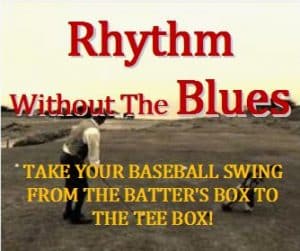
ESPY Golf Swing Coach- Developing the golfer’s Rhythm w/o creating the golfer’s Blues.
Also, learning The ESPY Golf Swing Coach process is an excellent way to develop Rhythm without experiencing the Blues in your golf game for confidence; learn how to take your baseball-style swing from the batter’s box to the tee box.
Please visit “The Locker Room” for an Index of all my golf articles to improve your golf game and life. Discover how you can take your baseball swing from the batter’s box to the tee box.
Learn How to take your baseball-style golf swing from the batter’s box to the tee box.
For Comments or questions please contact me at 1-888-514-1228 Mon – Fri from 9 am to 4 pm CT Zone.
A Recommendation for your Golf Game:

I would like to recommend an interesting radio program that I regularly listen to from my home state Arkansas on my I-Heart Radio app on KARN 102.9 FM station, out of Little Rock, AR. They air a golf show called Arkansas Fairways and Greens, at 7:00 AM CT each Saturday morning, hosted by Bob Steel, and co-hosted by Jay Fox and Charles Crowson. Bob occasionally as has his guess Alex Myers with Golf Digest and Ron Sirak with Golf Channel. I was interviewed on his show about my book, The ESPY Golf Swing Coach. This show is worth tuning into for golf news and information.
Jay Fox is an Administrator with Arkansas State Golf Association that discuss amateur golf and rules of the game.
Check out my full library of BLOGS @ www.espygolfapp.com/blog or purchase your copy of “The ESPY Golf Swing Coach” @ www.espygolfapp.com/store.
Facebook – The QATSPY Golf Approach
Twitter – @cwboatright
Google+ – ESPY Golf Swing Coach
YouTube – ESPY Golf Swing Coach
Once you learn WHY, you don’t forget HOW!
YouTube Videos:
https://youtu.be/ZGVNrIw_wlo (Cam & Cam-over elements)
https://youtu.be/K2FDHZ3AX9w (Figuring your proper swing plane)
https://youtu.be/TO82PMO6G8M (Developing muscle memory)
Two decisions that you can make for yourself and your kids are to get a copy of my book and place the book and a golf club into their hands. You will never look back, but only forward. You will not miss with this for yourself and/or your kids.



